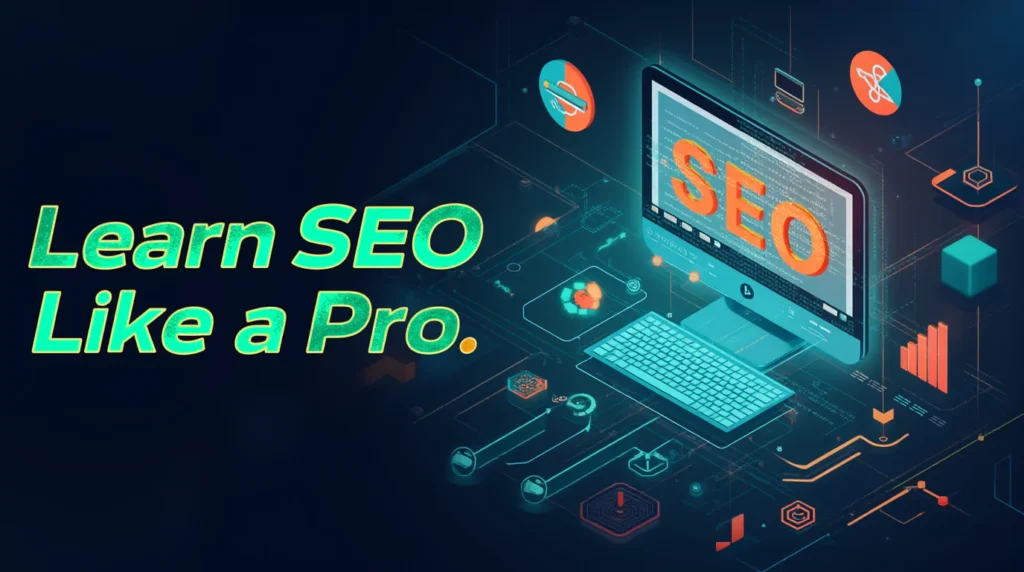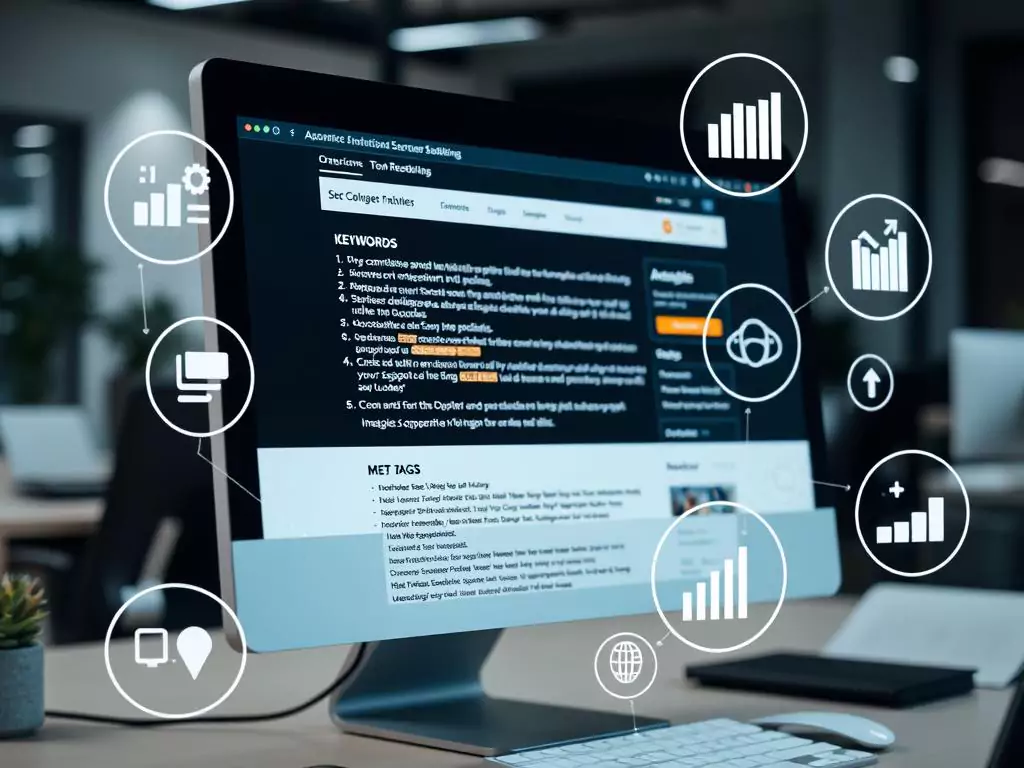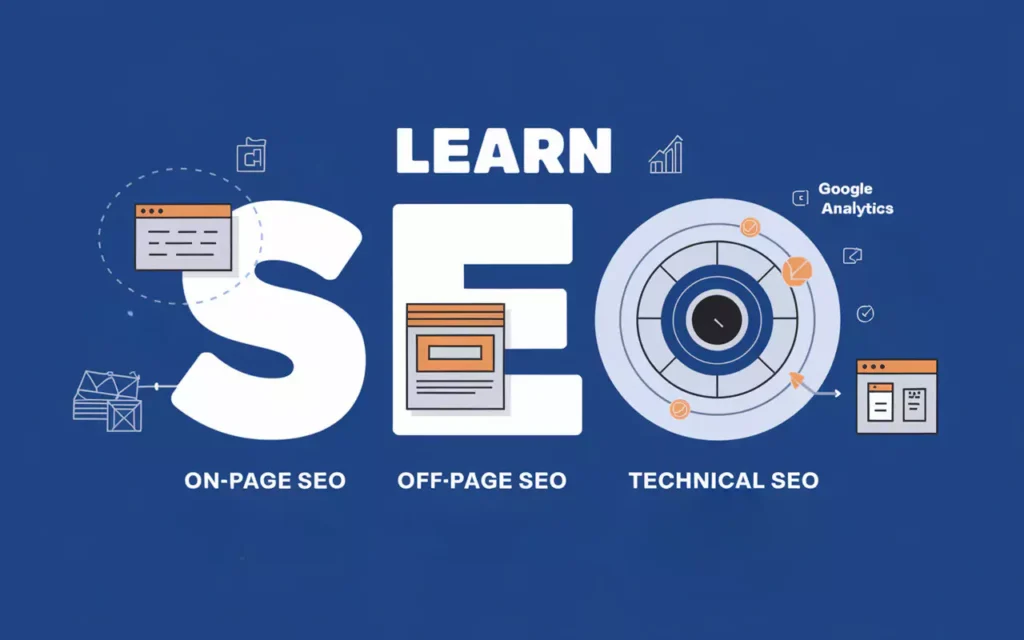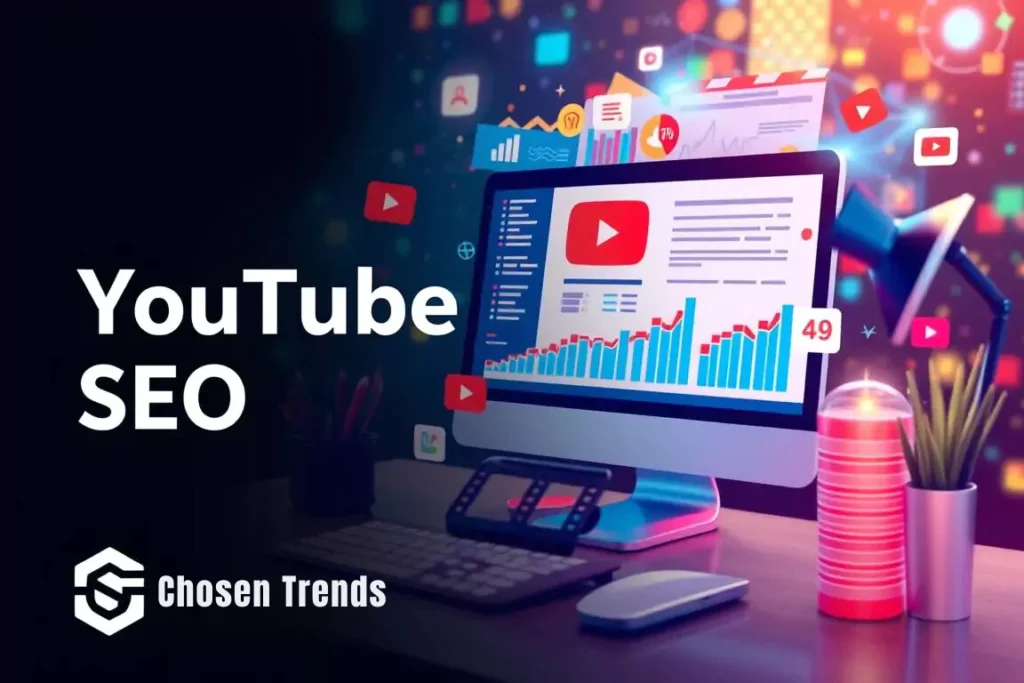SEO for Beginners: Your Step-by-Step Guide
Did you know 75% of users never look beyond the first page of search results? This shows how vital Search Engine Optimization (SEO) is today. If your site isn’t on the first page, you’re losing a lot of visitors and potential customers.
This guide is for beginners, covering the basics of SEO. It includes strategies and best practices to make your site more visible. It’s perfect for small business owners, content creators, or anyone wanting to learn SEO. You’ll get the tools and knowledge to improve your website’s ranking.

Key Takeaways
- Search Engine Optimization (SEO) is key for better website visibility and more targeted traffic.
- This guide teaches you the basics of SEO, like on-page optimization, keyword research, and content creation.
- Good SEO strategies can help your site rank higher and reach more people.
- Keeping up with the latest SEO best practices is important to stay ahead online.
- Using the right SEO tools and resources can make optimizing your site easier and faster.
Understanding Search Engine Optimization Fundamentals
To succeed in the world of search engine optimization (SEO), you need to understand the basics. These basics help search engines rank your content. This knowledge is key to making your website more visible and attracting more visitors.
How Search Engines Process and Rank Content
Search engines like Google, Bing, and Yahoo have a three-step process. They crawl, index, and rank web pages. They use algorithms to check if your content is relevant, quality, and authoritative. This decides where your website will show up in search results.
Core Components of SEO Success
- Keyword research and targeted content optimization
- Optimized on-page elements, like title tags and meta descriptions
- Technically sound website structure and infrastructure
- Building a strong backlink profile through ethical link building
- Continuous monitoring, analysis, and refinement of SEO strategies
The Evolution of SEO Practices
The world of search engine optimisation seo is always changing. Search engines update their algorithms to give better results. This means seo engine optimization practices must also change. Now, they focus on creating content that’s valuable to users and building a strong online presence through seo digital marketing strategies.

“The key to successful SEO is to create a website that is both user-friendly and search engine-friendly.”
Essential On-Page SEO Elements You Need to Master
Improving your website’s on-page SEO is key to getting more visibility and better rankings. Mastering the essential on-page SEO elements can greatly boost your website’s organic traffic. This is true for WordPress sites and other platforms alike.
Title Tags and Meta Descriptions
Your title tags and meta descriptions are what users see first in search results. Creating catchy, keyword-rich title tags and meta descriptions can draw more clicks. Make sure your title tags match the page’s content and include your target keywords.
Header Tags and Content Structure
Using header tags (H1, H2, H3, etc.) helps search engines understand your content’s structure. Include relevant keywords in your header tags to highlight each section’s topic. A clear content structure also improves user experience and SEO.
Image Optimization and Alt Text
Optimizing your images is crucial for SEO. Ensure your images are the right size, compressed, and named with relevant keywords. Always include descriptive alt text to help search engines and improve accessibility.
| On-Page SEO Element | Importance for SEO | Best Practices |
|---|---|---|
| Title Tags | Helps search engines understand the page’s content and relevance | Include target keywords, keep within 50-60 characters |
| Meta Descriptions | Influences click-through rates from search engine results | Summarize the page’s content, include target keywords, keep within 150-160 characters |
| Header Tags | Provides structure and hierarchy to content, signals importance to search engines | Use H1 for the main topic, H2-H6 for subtopics, include relevant keywords |
| Image Alt Text | Improves accessibility and gives search engines context about the image | Describe the image accurately with relevant keywords |
Mastering these essential on-page SEO elements can greatly improve your website’s visibility and ranking. This drives more qualified traffic and potential customers to your WordPress site or any other website.

Keyword Research: Finding the Right Search Terms
Effective keyword research is key to a good SEO strategy. It’s about finding the search terms people use to find what you offer. By using seo search keyword tool, keyword research tool, and KWFinder, you can make content that meets user needs. This boosts your chances of ranking well on search engine results pages (SERPs).
To start keyword research, brainstorm a list of keywords related to your business. Then, use seo search keyword tool and keyword research tool to check the search volume, competition, and relevance of these keywords.
- Identify long-tail keywords: These are more specific, often-longer search terms that tend to have lower competition but higher conversion rates.
- Analyze search intent: Understand whether your target keywords are informational, navigational, or transactional in nature, and tailor your content accordingly.
- Evaluate keyword difficulty: Use KWFinder to assess the level of competition for each keyword, and prioritize those that strike the right balance between search volume and difficulty.
By doing deep seo search keyword tool, keyword research tool, and analysis, you can create a strong keyword strategy. This strategy meets your audience’s needs and helps you rank higher in search results. It brings more qualified traffic to your site and boosts your conversion chances.
“The key to successful SEO is keyword research – it enables you to create content that your audience is actively searching for.” – Neil Patel, digital marketing expert
Creating SEO-Friendly Content That Ranks
Making content that is SEO-friendly is key to any seo strategy. Your content needs to be top-notch and meet the needs of your audience. This way, it will rank well on search engine results pages (SERPs).
Content Quality and User Intent
Understanding seo blog writing is crucial. Your content should be both informative and engaging. It must also match what your audience is searching for.
By focusing on your audience’s needs, you make your content more valuable. This increases the chance of search engines choosing it as a top resource.
Proper Keyword Integration
Using the right keywords is vital for surfer seo success. But, don’t overdo it. Keyword stuffing can hurt your rankings.
Instead, aim for natural keyword use. This should make your content easier to read and understand.
Content Structure and Readability
The way you structure and write your content matters a lot for SEO. Use simple language and organize your content well. This makes it easy for readers to follow along.
Also, make sure your content flows smoothly. This keeps your readers interested from the beginning to the end.
By focusing on quality, user intent, and proper keyword use, you can make content that ranks well. It will also be valuable to your audience.
Technical SEO: Making Your Site Search Engine Ready
In the fast-paced world of digital marketing, technical SEO is key to getting your website seen and ranked. It deals with the behind-the-scenes stuff, making sure your site is easy for search engines to find and use. This includes making sure your site works well on mobile devices.
Site speed optimization is a big part of technical SEO. Fast websites are better for users and show search engines that you care about your site. Tools can help you find and fix speed problems, like making images smaller and caching data in browsers.
It’s also important for your site to be mobile-friendly. Most searches happen on phones now, so search engines favor sites that work well on all devices. A site that looks good and works well on phones can really help your SEO site checkup scores.
Technical SEO also means setting up XML sitemaps and robots.txt files. These help search engines understand your site better. They guide search engines through your site, making it easier for them to find and list your pages.
Lastly, using schema markup can give search engines more info about your site’s content. This can make your site’s listings in search results more detailed and attractive. This can draw more people to your site.
By following these technical SEO tips, you can make sure your website is ready for search engines. This will help your content reach more people and engage with your audience better.
Building Quality Backlinks for Better Rankings
In SEO, backlinks are key to success. They come from other websites and show search engines your content is valuable. For beginners, learning about seo backlinks can be tough. But, with the right steps, you can boost your website’s visibility.
Link Building Strategies for Beginners
Guest posting is a great way to get backlinks. Look for blogs in your field and offer article ideas. This can get you quality backlinks and new readers.
Use your network too. Talk to partners and peers about link exchanges. This can grow your backlink audit and create strong partnerships.
Avoiding Toxic Backlinks
It’s vital to watch out for bad backlinks. These can hurt your rankings and even get you penalized by Google. Keep an eye on your backlinks and remove any bad ones to keep your profile healthy.
Monitoring Your Backlink Profile
Keeping an eye on your backlinks is crucial for SEO success. Use tools like Google Search Console or Ahrefs to track your seo backlinks. This helps you find new opportunities and fix any problems. Stay active and your backlinks will help your website rank better.
Getting good seo backlinks takes time and work. But, it’s worth it. Follow these tips and keep your backlinks in check. This will help your website rank higher and attract more visitors.
Local SEO: Optimizing for Geographic Relevance
In today’s digital world, having a strong online presence is key for any business. Local SEO is especially important for small and medium-sized businesses. It helps you show up in local search results and draw in more customers from your area.
One key part of local SEO is optimizing your Google My Business listing. This free platform lets you share your business info, like address and hours. Having a complete and accurate listing can boost your website ranking and help local customers find you.
Creating content that’s specific to your area is also crucial. This means writing blog posts and web pages that speak to your local market. It shows you know your stuff and can attract more customers.
Managing your online reviews is also vital. Good reviews build trust and tell search engines you’re reputable. Answering both positive and negative reviews helps keep your online reputation strong.
Local citations, or mentions of your business on other sites, are important too. Keeping your business info consistent across the web boosts your credibility. This can help your search engine rankings.
| Local SEO Strategy | Benefits |
|---|---|
| Optimizing Google My Business listing | Improved visibility in local search results, enhanced business information for customers |
| Creating location-specific content | Demonstrates expertise and relevance, leads to higher search engine rankings |
| Managing online reviews | Builds trust with potential customers, improves online reputation and visibility |
| Maintaining consistent local citations | Enhances business credibility and search engine rankings |
By using these local SEO strategies, businesses can get more visible online. This attracts more local customers and boosts your website ranking and success.
Mobile Optimization: Ensuring Mobile-First Success
In today’s world, mobile devices are everywhere. Making your website mobile-friendly is not just a choice; it’s a must. The seo analyzer, website ranking checker, and search console tools all say mobile optimization is key. It affects your website’s search rankings and success online.
Responsive Design Principles
A responsive design makes your website work well on all devices. It ensures your site looks great and works smoothly on phones and tablets. By following responsive design rules, your site’s content and layout will be perfect for mobile users. This makes your site better for users and search engines alike.
Mobile Page Speed Optimization
Mobile users hate waiting for websites to load. Making your site fast on mobile is essential. It makes users happy and helps your site rank better in search results. You can make your site faster by compressing images and using browser caching.
Mobile User Experience Factors
There’s more to mobile optimization than just design and speed. Navigation, clear calls-to-action, and easy-to-read content are also important. By focusing on these, you create a great experience for mobile users. This keeps them on your site and encourages them to take action.
Mobile optimization is now a must in the digital world. By focusing on responsive design, speed, and user experience, your website will do well. It will be ready for the changing search engine world.
Essential SEO Tools and Resources
SEO can seem overwhelming, but the right tools make it easier. This section covers key SEO tools, both free and paid. They help improve your website’s ranking and visibility.
Tools like Semrush and Ubersuggest are great for keyword research. Moz offers a full SEO suite with valuable insights. These tools are essential for optimizing your site and content.
It’s also important to learn from SEO experts and communities. Sites like Backlinko and Ahrefs have lots of educational content. Online forums and social media groups connect you with others who share your interests.
Whether you’re new to SEO or want to improve, these resources are a great start. Using these tools and learning more will help you succeed in SEO. You’ll be ready to handle the changes in search engine optimization and reach your goals.
FAQ
SEO makes your website more visible in search engine results. It aims to bring more people to your site by improving its ranking.
SEO boosts your website’s visibility and credibility online. It helps you rank higher in search results. This attracts more visitors who are likely to be interested in your products or services.
SEO has three main parts. On-page optimization includes things like title tags and content. Off-page optimization is about links and social media. Technical SEO focuses on site speed and mobile-friendliness.
Search engines use algorithms to rank websites. They look at content quality, relevance, and user experience. They also consider authority signals to find the best results for a search.
Organic search is free and natural. Paid search, or PPC, shows ads for a fee. Both can help your site appear in search results.
Good keyword research finds what people search for. Look at search volume and competition. Choose keywords that match your content and are likely to attract visitors.
Quality content is key for SEO. It should be informative and engaging. It helps improve your site’s ranking and credibility, and keeps users interested.
Get backlinks from trusted sites. Use guest posts, broken link building, and influencer outreach. Create content that people want to share and link to.
Focus on site speed, mobile-friendliness, and XML sitemaps. Use robots.txt files and schema markup. Fix any issues found in Google Search Console.
For local SEO, claim your Google My Business listing. Create content for your area. Manage online reviews and build local citations.


